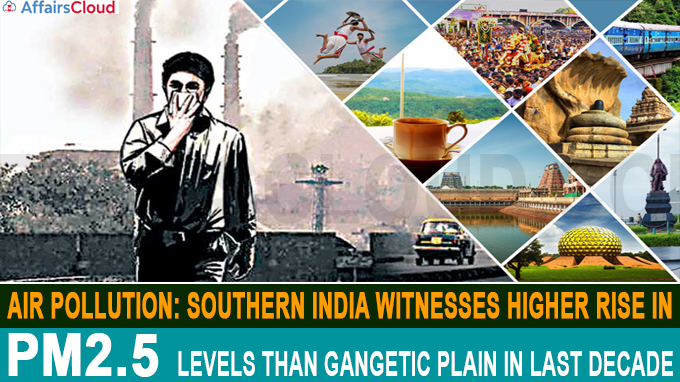 According to a survey conducted by CPCB-IITD (Central Pollution Control Board-Indian Institute of Technology, Delhi), Southern India & Eastern India recorded a higher rate of increase in pollution levels than the Indo-Gangetic Plain (IGP). The study was conducted based on Satellite Data from 2000-2019, which is the First-of-its Kind survey to look at air pollution spatially.
According to a survey conducted by CPCB-IITD (Central Pollution Control Board-Indian Institute of Technology, Delhi), Southern India & Eastern India recorded a higher rate of increase in pollution levels than the Indo-Gangetic Plain (IGP). The study was conducted based on Satellite Data from 2000-2019, which is the First-of-its Kind survey to look at air pollution spatially.
i.The survey has also found that Air Pollution in Rural India has increased at par with Urban India.
ii.The states of Kerala (Urban 24.2%, Rural 21.9%), Goa (Urban 36.4%, Rural 37.3%), Andhra Pradesh (Urban 20.15, Rural 18.9%) recorded the highest levels of pollution during the period.
States with Highest Levels of Pollution (2000-19):
| State | Pollution at Urban level | Pollution at Rural level |
|---|---|---|
| Kerala | 24.2% | 21.9% |
| Goa | 36.4% | 37.3% |
| Andhra Pradesh | 20.15% | 18.9% |
CPCB-IITD Survey:
i.The study has been commissioned by the Central Pollution Control Board (CPCB).
ii.The author of the study is Professor Sagnik Dey of IIT, Delhi.
Key Findings:
i.Delhi’s PM 2.5 (Particulate Matter) has increased by 10.9 % between 2001 to 2015, whereas in the time frame PM 2.5 exposure in rural India increased by 11.9% thus emphasizing that rural India is at par with Urban India in Air Pollution.
ii.The rate of increase of PM2.5 over Eastern and Southern India is more than 1.6% per year (2000-19) & IGP reported less than 1.2% per year (2000-19).
iii.Across India 436 cities/towns with population of more than 1 Lakh in 2019 exceeded the National Ambient Air Quality Standard (NAAQS) of 40 Micrograms per metric cube (μg/m3) in 2019.
iv.99.5 % of districts in India did not meet the World Health Organisation’s (WHO) air quality guideline of 10 μg/m3 as of 2019.
v.The study also states that PM 2.5 level in Gangetic plain and Western Part of India is Two Times more than the Annual NAAQS.
PM 2.5 Levels between 2000-2010:
i.State which recorded Increase in Pollution Levels – Jharkhand, Chhattisgarh, Odisha, Telangana, Andhra Pradesh, Tamil Nadu, Kerala, and parts of Karnataka, Maharashtra and Northeast regions.
ii.State which recorded Decrease in Pollution Levels – Jammu & Kashmir (J&K), Ladakh, Himachal Pradesh, and Desert regions recorded downfall in pollution levels.
PM 2.5 Levels between 2010-2019:
i.States which recorded Increase in Pollution Levels – West Bengal, Odisha, Telangana, Maharashtra and parts of Gujarat, Karnataka, Bihar, Uttar Pradesh, Madhya Pradesh and Uttarakhand
ii.State which recorded Decrease in Pollution Levels – Eastern Part of J&K (Now Union Territory of Ladakh) and parts of Rajasthan recorded a downfall in pollution.
Causes of Increase in Air Pollution:
i.The Cause of increase in pollution in Odisha & Chhattisgarh (Highest in Eastern India) is mainly due to mining activities and thermal coal power plants.
ii.High Urbanisation in cities like Bengaluru, Hyderabad were the main reason behind increased emissions in South India.
iii.While unfavourable Meteorological Conditions in eastern and peninsular India coupled with increase in emission has led to overall increase in Pollution levels.
iv.The study has noted that the rise in pollution in rural India is due to high reliance on solid fuel (Biomass & Coal) for domestic use. Household sources are the “largest contributor to ambient PM 2.5 in India”.
Pradhan Mantri Ujjwala Yojana (PMUY):
Pradhan Mantri Ujjwala Yojana (PMUY) launched in 2016 aims to provide LPG (Liquefied Petroleum Gas) connection to women from Below Poverty Line (BPL) households.
i.The scheme will be essential in tackling pollutants at the rural level.
ii.It is a scheme of the Ministry of Petroleum & Natural Gas.
National Clean Air Programme:
The spatial mapping of pollution will be useful for the government in designing policies under the National Clean Air Programme.
Recent Related News:
i.On September 18, 2020, a high-level task force led by Dr Pramod Kumar Mishra, Principal Secretary to the Prime Minister reviewed the action taken by agencies and firm up plans for the coming harvesting and winter season.
About Central Pollution Control Board (CPCB):
Chairman – S.P.S. Parihar
Headquarters – New Delhi
About Indian Institute of Technology, Delhi (IIT, Delhi):
Chairman (Chairperson, Board of Governors) – Dr. R. Chidambaram
Director (Ex-Officio Member) – Professor V Ramgopal Rao




